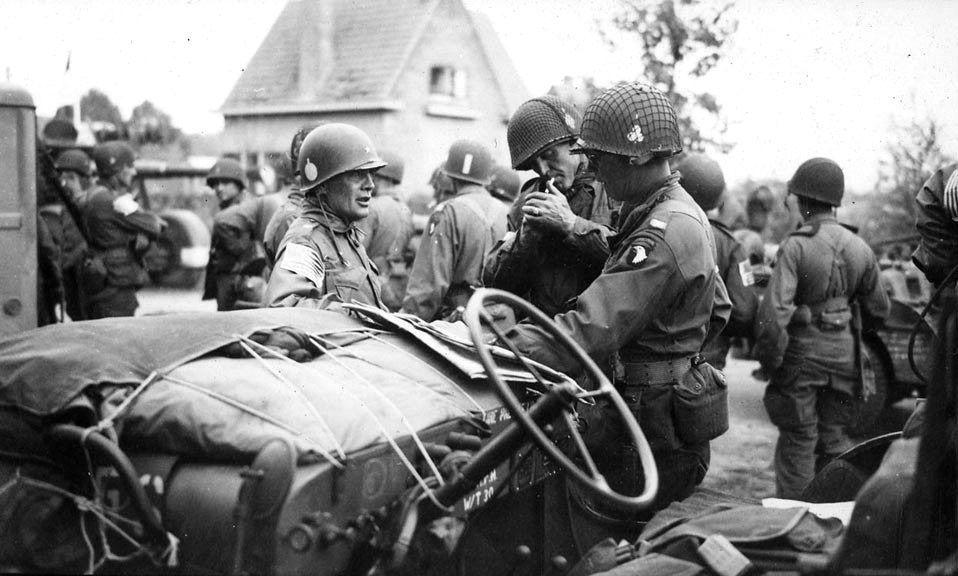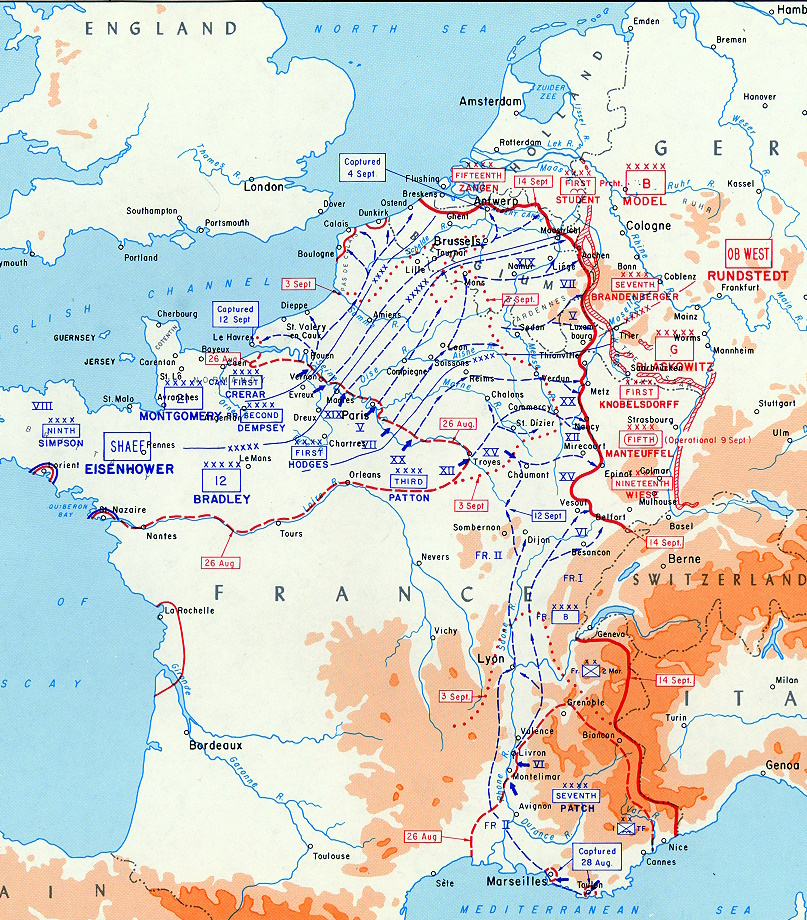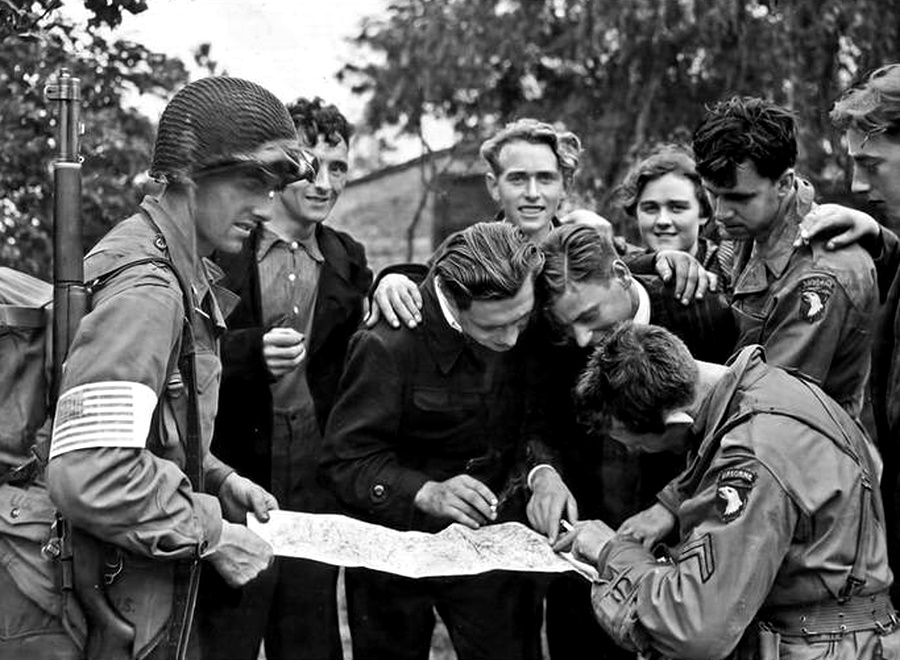Document Source: Operations of the 506th Parachute Infantry Regiment, 101st Airborne Division, in Holland, September 17 to October 9, 1944. Rhineland Campaign. Capt Lloyd E. Wills, Assistant Regimental Operations Officer.
This archive covers the operation of the 506th Parachute Infantry Regiment, 101st Airborne Division, in Holland from September 17, 1944, to October 9, 1944, during Operation Market. In order to orient the reader a short resume of events leading up to this operation is given.
On June 6, 1944, the Allies launched a coordinated airborne-seaborne assault on the Western Coast of France, the Normandy Peninsula, in the vicinity of Carentan and Caen. By mid-September they had advanced across France and were knocking at Germany’s West Wall, the Siegfried Line defenses. The line now held was Canadian First and British Second Armies along the Meuse-Escaut Canal; US First Army was in contact with the West Wall defenses; US Third Army held a bridgehead over the Moselle River, and US Seventh Army and French Forces, having invaded Southern France in August, had advanced generally along the Rhone River Valley contacting the US Third Army.
To bring the total weight of the Allied Forces in Western Europe to bear on the enemy would require a deep penetration through this deliberate defense belt. In the south, the Allies had no choice except a head-on advance into the West Wall. However, in the north, they might be able to advance north through Holland and out-flank this West Wall. The successful execution of such an operation would permit the Allied armor more suitable terrain over which to operate as compared to the terrain that would be encountered in the execution of deep penetration in the south. From the plains in Northern Germany the Allies could envelop the Rhur Area, Germany’s principal industrial area, from the northeast. The Allied High Command deemed the results of such an operation, if successful, so important that it was decided to make an attempt.
GENERAL PLAN
The overall plan called for the British Second Army to launch the main offensive advancing quickly to the Zuider Zee, the low coastal area in Northern Holland, thereby forcing a bridgehead over the Rhine River and trapping all enemy forces along the coast. The First Canadian Army would advance north and secure the deep water Port of Rotterdam and protect the left flank of the British Second Army. The US First Army would protect the right flank of the British Second Army by launching an offensive toward the Rhine River, the US Third Army would defend from present positions, and the US Seventh Army and French Forces would reorganize in present positions and be prepared for future offensive operations.
For this operation, the British Second Army planned an advance along a very narrow corridor – general line Eindhoven – Uden – Grave – Nijmegen – Arnhem. The road net along this route provided only one principal route of advance, the main highway through the above-mentioned towns. This would necessitate a very detailed traffic plan to accommodate the vehicles required for this operation. The British 30th Corps would spearhead the advance with the British 8th and 12th Corps advancing at a slower pace on the right and left respectively. Airborne troops would be dropped along this corridor at Zon, Veghel, Grave, Nijmegen, and Arnhem to assist the advance of the 30th Corps by seizing and securing vital bridges over the Wilhelmina Canal at Zon, the Willems Vaart Canal at Veghel, the Meuse River at Grave, the Waal River at Nijmegen, and Neder Rijn River at Arnhem.
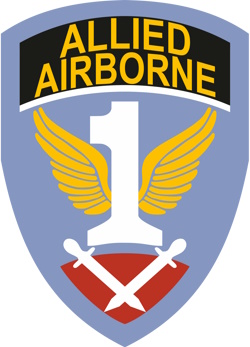
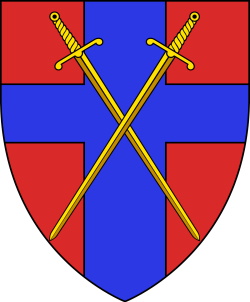 Past airborne operations in North Africa, in Sicily, Italy, in Normandy and Southern France, increasingly indicated the need for an overall command of airborne and troop-carrier forces. As a result, the First Allied Airborne Army consisting of the US 82nd and 101st Airborne Divisions, the British 1st Airborne Division, the British 51st Airtransportable Division, and one Polish Airborne Brigade with all available troop-carrier forces was created in England on August 8, 1944. Gen Lewis H. Brereton, formerly Commanding General of US Ninth Air Force, was placed in command. First Allied Airborne Army would be under the operational control of the British 21st Army Group, which was commanded by Field Marshal Montgomery. The Airborne Army Commander would be directly responsible to the Supreme Commander – Gen Eisenhower.
Past airborne operations in North Africa, in Sicily, Italy, in Normandy and Southern France, increasingly indicated the need for an overall command of airborne and troop-carrier forces. As a result, the First Allied Airborne Army consisting of the US 82nd and 101st Airborne Divisions, the British 1st Airborne Division, the British 51st Airtransportable Division, and one Polish Airborne Brigade with all available troop-carrier forces was created in England on August 8, 1944. Gen Lewis H. Brereton, formerly Commanding General of US Ninth Air Force, was placed in command. First Allied Airborne Army would be under the operational control of the British 21st Army Group, which was commanded by Field Marshal Montgomery. The Airborne Army Commander would be directly responsible to the Supreme Commander – Gen Eisenhower.
 By the time the First Allied Airborne Army was six weeks old its staff had planned four operations, three were canceled due to the rapid advance of the Allies across France. The target date set for Operation Market was September 17, 1944. The First Allied Airborne Army assigned missions to its divisions as follows: the 101-A/B would land in the vicinity of Zon and Veghel, secure the bridges at Veghel, St Oedenrode, Zon, and capture the city of Eindhoven; The 82-A/B would land in the vicinity of Grave and Nijmegen, secure the bridges at Grave, Nijmegen, and over Meuse-Waal Canal in the vicinity of Heumen; the British 1st Airborne Division and the Polish Brigade would land in the vicinity of Arnhem and secure the bridges there. Due to the number of aircraft required for the initial lift of these divisions, it was decided to use two routes, the Northern route, and the Southern route. The principal advantage of using two routes was that troop-carrier aircraft would be dispersed over a much larger area and enemy fighters could not concentrate on one point.
By the time the First Allied Airborne Army was six weeks old its staff had planned four operations, three were canceled due to the rapid advance of the Allies across France. The target date set for Operation Market was September 17, 1944. The First Allied Airborne Army assigned missions to its divisions as follows: the 101-A/B would land in the vicinity of Zon and Veghel, secure the bridges at Veghel, St Oedenrode, Zon, and capture the city of Eindhoven; The 82-A/B would land in the vicinity of Grave and Nijmegen, secure the bridges at Grave, Nijmegen, and over Meuse-Waal Canal in the vicinity of Heumen; the British 1st Airborne Division and the Polish Brigade would land in the vicinity of Arnhem and secure the bridges there. Due to the number of aircraft required for the initial lift of these divisions, it was decided to use two routes, the Northern route, and the Southern route. The principal advantage of using two routes was that troop-carrier aircraft would be dispersed over a much larger area and enemy fighters could not concentrate on one point.
The British 1st Airborne Division, the Polish Brigade, and the US 82-A/B would use the Northern route to landing areas, while the 101-A/B would use the Southern route. Both routes had their special hazards; the Northern route would be over some eighty miles of enemy territory and known enemy flak positions while the Southern route would be directly over the enemy front-line positions. A daylight landing was decided upon due to the fact that the German night fighter force was relatively intact, and Allied air superiority would be more effective during daylight.
REGIMENT’S PREPARATION FOR THE HOLLAND MISSION
The 506th Parachute Infantry Regiment, 101st Airborne Division, participated in the initial assault on Normandy on June 6, 1944. The bulk of the regiment’s action was in the vicinity of Carentan. The regiment was relieved from the line in Normandy on June 28, and returned to its home base near Hungerford, England on July 12, 1944, to prepare for future airborne missions on the continent. From July 13 to September 13, 1944, training was conducted in small unit and field firing exercises, known distance, rocket launcher, mortar, rifle grenade firing, and hand grenade throwing. A three-day isolated platoon problem was conducted by all battalions. In addition to the training conducted, the regiment moved twice to marshalling areas for airborne missions however, due to the rapid advance of the Allied armies, these missions were canceled. Replacements were received, arms and equipment checked, and everything was made ready for any future operation.
THE MARSHALLING AREA AND THE MISSION
On September 14, 1944, the regiment was ordered to the marshalling areas for the third time since returning from Normandy. Due to the previous moves to the same marshalling areas, very little reconnaissance was required prior to the actual move. By 1200 hours, September 15, all units of the regiment were sealed in their respective areas; Regimental Headquarters Company and 2nd Battalion at Membury Airfield, 1st Battalion at Ramsbury Airfield, and 3rd Battalion at Chilbolton Airfield. After the regiment had closed in the marshalling areas, its mission was received which was as follows: land on DZ C, secure the bridges over the Wilhelmina Canal in the vicinity of Zon and capture the city of Eindhoven. This mission was further assigned to the battalions as follows: the 3rd Battalion would land on the assigned DZ and secure it against enemy small arms fire. The 1st Battalion would land following the 3rd Battalion and move immediately to seize the bridges at Zon. The Regimental Headquarters Company and the 2nd Battalion would land, assemble, move east, and attack Zon from the north. Upon the accomplishment of these missions, the entire regiment would move south and capture Eindhoven.
From the time the regiment was sealed in the marshalling areas to its departure, all troops were briefed and rebriefed on each individual’s part of the mission. During this period ammunition, equipment, rations, anti-motion sickness pills were issued, parachute harness was adjusted to each individual, heavy equipment that could not be carried on the individual was rolled and packed in aerial delivery units, (81-MM mortars, etc) units were broken down into plane loads, and a loading manifest was prepared for each plane.
AIRCRAFT ALLOTTED TO THE REGIMENT
For this operation, the regiment was allotted one hundred and thirty-two C-47 Skytrain transport planes, and eight CG-4A Waco Gliders. Of this number, 131 planes and 6 gliders hit the DZ. One plane and two gliders were shot down over enemy territory. 2190 personnel emplaned for Holland, and 2183 actually jumped or landed by glider on the DZ, the remaining 7 did not jump due to the reserve parachute breaking open.
DEPARTURE
At about 0900 hours on September 17, 1944, the regiment commenced loading in the planes, and by 1000 hours the regiment was airborne and on its way to Holland to play its assigned role in Operations Market.
The regimental Pathfinder Team, commanded by 1/Lt Gordon O. Rothwell, took off from Chalgrove Airfield at 1040 hours and dropped on the DZ C at 1255 hours. Upon crossing enemy lines very heavy flak was encountered, but the plane took no evasive action other than to speed at 180 MPH. Enemy resistance was very slight on the DZ and did hot hinder the team in its mission. Within four minutes after landing all navigational aids were in readiness for the incom±ng serials. The initial serials all arrived on course three minutes late 1319, 1322, and 1325 hours. DZ C and DZ B consisted of adjacent fields and no defined boundary existed making it difficult to distinguish one from the other. However, from 1319 to 1325 hours three serials landed on each DZ making a total of two infantry regiments landing in the area within six minutes.
REGIMENTAL SERIAL
The trip was uneventful for the regimental serials until the coast of France was reached. Here, the fighter escort, a most welcome sight indeed, was picked up. This escort continued on to the DZ. As the serials would draw fire from the enemy flak positions the escorting fighters would immediately attack these positions and as a result, the flak was much reduced. As the serials passed over the British Second Army’s positions, their front line was very prominently outlined by identification panels and orange smoke. This gave everyone a good feeling as this was the signal that the British were ready to jump off as soon as the airborne serials cleared their front line. As the DZ was approached, enemy flak guns commenced firing on the serials from positions in the immediate vicinity of the bridge in Zon, the 1st Battalion objective. Some planes were hit by these guns, but none were shot down and all the parachutists were dropped on the DZ.
THE JUMP AND ATTACK ON THE ZON BRIDGE
Elements of the 3rd Battalion commenced jumping at 1319 hours and by 1325 hours the regiment, less the seaborne echelon, was on Dutch Soil. The landing was not opposed by hostile small-arms fire and the assembly was accomplished very quickly, and within one hour the 1st Battalion was engaging the enemy flak guns that had fired on the serials from the vicinity of the Zon bridge. As the Regimental Headquarters and 2nd Battalion were assembling, five enemy tanks approached the DZ from the east; but before they could do any damage they were taken under fire by friendly fighters, two being knocked out and the remainder driven off. The regiment, less the 1st Battalion, assembled and moved east to the Zon – St Oedenrode highway then south into Zon. This force reached Zon at approximately 1530 hours. Upon reaching Zon the 2nd Battalion immediately attacked the enemy flak positions from the north in conjunction with the 1st Battalion attacking from the west.
The enemy withdrew across the Wilhelmina Canal in the face of this attack and as the leading elements of the 2nd Battalion were within 100 yards of the bridge the enemy blew it from the other side of the Canal. Five dual-purpose 88-MM guns were knocked out in the vicinity of the bridge. The Canal at this point was about 75 feet wide. By use of some electric light poles that happened to be in the vicinity and the debris from the bridge, a footbridge was constructed and the regiment began crossing the canal at about 1300 hours. The leading elements of the 2nd Battalion had advanced about one and one-half miles toward Eindhoven after crossing the Canal to a small village, Bokt. Here, the Regimental Commander decided to stop for the night and resume the attack at dawn the next morning – September 18. By 2400 hours, all units of the regiment were across the Canal and in defensive positions in the vicinity of Bokt. During the night, plans were completed for the attack on Eindhoven at dawn. Since this was to be a head-on attack it was decided to attack in a column of battalions – 3rd Battalion leading.
CAPTURE OF EINDHOVEN
At dawn, September 18, the battalions moved out and by 0900 hours the 3rd Battalion had advanced to the outskirts of Eindhoven against light resistance. Upon entering the built-up area the battalion immediately came under heavy fire from enemy positions inside the buildings. The advance continued for approximately the distance of five city blocks where it was stopped cold by intense fire from enemy machine guns and dual-purpose 88-MM guns from positions in buildings and street intersections. By 1800 hours it was apparent that the 3rd Battalion could not dislocate the enemy from his positions. It was about this time that radio contact was established with reconnaissance elements of the British Guards Armored Division approaching the city from the west.
Since the 3rd Battalion could not advance it was decided to envelop the enemy positions from the east. The 1st Battalion was ordered to move to a position east and just short of the 3rd Battalion, while the 2nd Battalion was committed east and wide of the 1st Battalion in an attempt to outflank the enemy. The 2nd Battalion was successful in its enveloping move and entered the city proper at about 1300 hours. Upon finding their position out-flanked the enemy began withdrawing toward the center of the city proper only to find themselves surrounded by the 2nd Battalion. Approximately 300 enemies were killed or captured by the regiment upon its entry into Eindhoven. Upon entry into the city, the battalions commenced to mop up and by 1700 hours the first Dutch city was in Allied hands. Defensive positions were established on the east and west sides of the city for the night. Advanced elements of the Guards Armored Division were contacted on the south side of the city at about 1900 hours.





